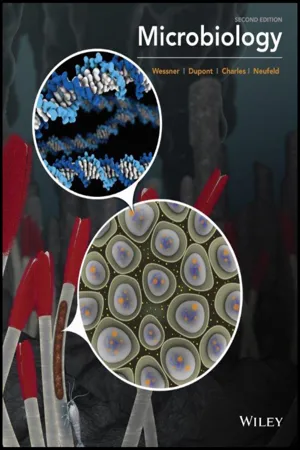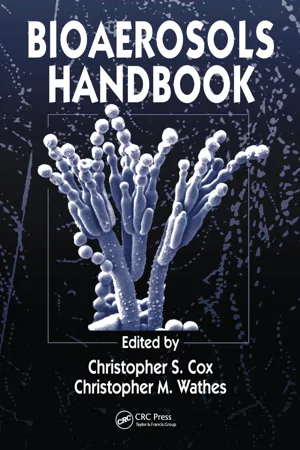Biological Sciences
Plaque Assay
Plaque assay is a technique used to measure the number of infectious particles in a virus sample. It involves infecting a layer of cells with the virus, allowing it to replicate, and then staining the cells to visualize the plaques, or areas where the virus has killed the cells. The number of plaques can be used to calculate the concentration of infectious virus particles in the original sample.
Written by Perlego with AI-assistance
Related key terms
Related key terms
1 of 4
Related key terms
1 of 3
3 Key excerpts on "Plaque Assay"
- eBook - ePub
General Virology
Biochemical, Biological, and Biophysical Properties
- F. M. Burnet, W. M. Stanley, F. M. Burnet, W. M. Stanley(Authors)
- 2013(Publication Date)
- Academic Press(Publisher)
Dulbecco (1952) for the development of a plaque-count assay. This opened the door to quantitative studies with animal viruses equivalent in precision to those made with bacterial viruses. Bacterial and animal virus plaque-count assays are analogous in principle. The procedure in general is less susceptible to the errors and uncertainties inherent in the pock count assay on chorioallantoic membranes of chick embryos.Monolayer cultures for Plaque Assay are generally prepared by seeding trypsinized cells from freshly excised tissues (Dulbecco and Vogt, 1954a ; Youngner, 1954 ) or from cultures of established cell lines (Scherer et al ., 1953) in petri dishes or small flat bottles under an appropriate medium. The cells attach to the glass surface and produce a confluent growth after incubation at 37°C. for a varying number of days. Virus inocula are then introduced and the infected cultures layered with agar containing a maintenance medium. The necrotic plaques which ultimately appear in the sheet of healthy cells represent primary foci of infection. Secondary plaques fail to arise since virus dissemination is prevented by the agar overlay.The Plaque Assay has been applied to an increasing number of animal viruses. These include western equine encephalomyelitis and Newcastle disease viruses (Dulbecco, 1952 ; Dulbecco and Vogt, 1954b ); vaccinia (Noyes, 1953 ); the human polioviruses (Dulbecco and Vogt, 1954a ); fowl plague (Hotchin, 1955 ); certain strains of influenza virus (Ledinko, 1955 ; Granoff, 1955 ); foot-and-mouth disease (Sellers, 1955 ;Bachrach et al ., 1957); Rift Valley fever (Takemori et al ., 1955); as well as Coxsackie and ECHO viruses (Hsiung and Melnick, 1955 ).The sensitivity of the Plaque Assay of animal viruses varies greatly depending upon the virus and cell system used. For example, at one extreme, Granoff (1955) found that plaque titers of PR8 and MEL strains of influenza A assayed on epithelial cell cultures from chick embryo lungs were 800-fold less than the 50% egg infectious titer. In contrast, Dulbecco and Vogt (1954a) found that titers of poliovirus, type 1, obtained by Plaque Assay on monkey kidney cultures were slightly higher than the infectivity titer obtained by monkey titration. In studies relating physical particle to infective particle counts, it is desirable, obviously, to work with assay systems of the highest possible efficiency. Such needs have stimulated the search for more susceptible cell lines which can be rewarding, as exemplified by Fogh and Lund’s (1955) - eBook - ePub
- Dave Wessner, Christine Dupont, Trevor Charles, Josh Neufeld(Authors)
- 2016(Publication Date)
- Wiley(Publisher)
) . This simple technique provides a good measurement of the infectious viruses. Of course, it does depend on the ability of the virus being studied to lyse available host cells.Figure 5.21.By plating serial dilutions of a virus on susceptible host cells, one can determine the number of plaque-forming units (PFUs) in the original stock. In this assay, tenfold serial dilutions of a virus stock were added to each plate. As you can see, approximately tenfold fewer plaques are observed when the virus is diluted tenfold.Plaque Assay to determine viral titerA similar type of assay can be used to determine the infectious titer of plant viruses. Briefly, serial dilutions of a viral suspension are applied to previously scarified, or scratched, leaves. The scarification serves to break the cell walls, thereby allowing the viruses to enter the leaf cells. After a sufficient period of incubation, the numbers of lesions present on the leaves are counted. If one assumes that each lesion arose initially from the infection of a single cell by a single virion, then the number of lesions can be used to determine the concentration of the infectious viral particles ( Figure 5.22 ) .Figure 5.22.The plant leaf shows distinct lesions caused by ringspot virus. If a plant leaf is experimentally inoculated with virus, then these areas of localized cell death, analogous to plaques that form in a standard Plaque Assay, can be counted, thereby allowing one to determine the infectious titer of the virus.Using viral lesions on a leaf to determine the titer of plant virusA Plaque Assay of a particular viral sample may provide a titer that differs dramatically from a direct count of the same sample. For some viruses, the direct count may yield a value for the number of viral particles that is 100 or 1,000 times greater than the PFU titer. How can we interpret this apparent discrepancy? Let’s look at what each assay actually measures. In a direct count, every particle that looks like a virus is counted. In a Plaque Assay, every virus that results in the death of host cells is counted. In other words, the direct count measures the total number of viral particles, although the Plaque Assay measures the number of infectious particles. So, let’s reevaluate our apparent contradiction: if the direct count exceeds the PFU titer by a factor of 100, then we can assume that only one out of every 100 viral particles actually is infectious. For some reason, the other 99 particles are unable to infect cells. These defective viral particles may have been assembled incorrectly, are missing part of their genome, or contain mutations that preclude further replication. As we will see in Chapter 8 - eBook - ePub
- Christopher S. Cox, Christopher M. Wathes, Christopher S. Cox, Christopher M. Wathes(Authors)
- 2020(Publication Date)
- CRC Press(Publisher)
79The most common test system to determine infectivity of a given virus is the Plaque Assay. Monolayers of host cells are inoculated with appropriate dilutions of virus and to prevent the spreading of virus throughout the layer, after a short adsorption period, the culture is overlaid with a medium containing agar. After an appropriate incubation period, cytopathic effects start, usually focally, producing small plaques indicating infected cells. Theoretically, a single infective virus can induce one plaque-forming unit (PFU), but in most cases the ratio between the number of infective virus particles and the host cell is about 1,000:1. The main reasons for this phenomenon are (i) inhibition of viral replication caused by the agar overlay, (ii) aggregation of virus particles, and (iii) the presence of defective viral particles in the sample. When an air sample with unknown virus content has to be screened without focusing on a particular species, primary or secondary cell cultures should be given preference, because they allow a broad spectrum of virus species to multiply.79 Preferably, cell cultures derived from the host or related species should be utilized (see also Chapter 6 ). Rehumidification of the air sample is known to increase the number of PFU of some virus species.53 Infectivity assays to detect virus can be performed with collecting fluids, but in most cases large amounts of air have to be sampled before detectable numbers of infective virus particles can be provided for test performance.80 To prevent bacterial growth, 200 units of penicillin and 100 μg of streptomycin per mL may be added to the sample. Because collecting fluids are usually highly contaminated, the suspension has to be filtered through 0.45 μm and 0.22 μm pores. Aliquots are placed on cellular monolayers (limiting dilution of the sample may be done, if necessary) and incubated for 1 hour or more at 37°C to allow absorption of the virus particles. The collected specimens then may be removed or left on the cell culture, but fresh media should be added to the cultures. These should be observed for cytopathic effects following a 1 to 2 week incubation period. Most species of cytopathic viruses take 24 to 72 hours to induce the visible cytopathic effects (CPE), but this is a function also of the inoculated dose, while titration may be performed to evaluate the TCID50
Index pages curate the most relevant extracts from our library of academic textbooks. They’ve been created using an in-house natural language model (NLM), each adding context and meaning to key research topics.
Explore more topic indexes
Explore more topic indexes
1 of 6
Explore more topic indexes
1 of 4


